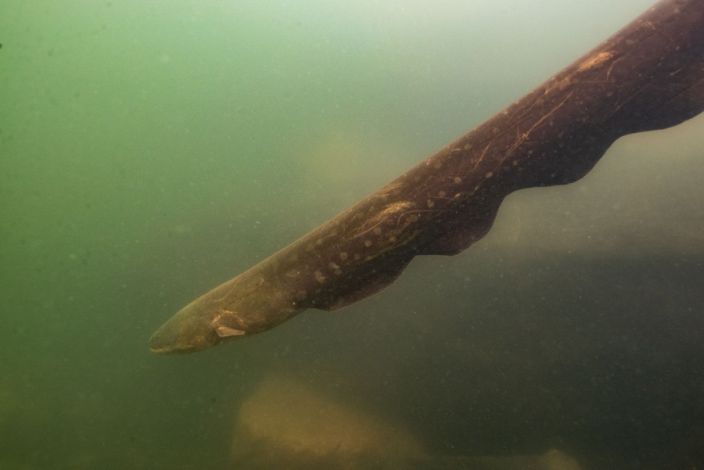In August 2012, Douglas Bastos, then a graduate student at Brazil’s Instituto Nacional de Pesquisas da Amazônia, was exploring a remote waterway in the Amazon rainforest when he came across a small lake teeming with electric eels.
Electric eels, which despite their name are actually a type of knifefish, were believed to be solitary creatures. And yet before Bastos’ eyes were more than 100 of them. Then things got even more jolting.
Bastos watched, astonished, as the writhing mass of eels began corralling groups of tetra fish into tightly packed balls and bombarding them with synchronized electric attacks that sent them flying.
“When I saw the tetras jumping after the attacks, I was in shock,” Bastos said. “Group hunting is a rare event in freshwater fishes. My first reaction was to run to the boat and get a camera.”
Two years later, Bastos and researchers from the Smithsonian National Museum of Natural History returned to the area to study this unusual phenomenon. The findings of their study, published Thursday in the journal Ecology and Evolution, overturn the idea that electric eels are exclusively solitary predators and raise new questions about the lives of these little-understood fish.
When the researchers returned to the site, along the banks of Brazil’s Iriri River, they confirmed that the electric eels Bastos had observed in 2012 were Volta’s electric eels, a recently discovered species that can reach 8 feet in length and are capable of producing 860-volt electric shocks — the strongest electric discharge of any animal.
For the past 250 years, scientists believed that all electric eels belonged to the same species, but in 2019, research conducted by C. David de Santana, a Smithsonian researcher, proved that there are at least three species, the largest and most electrified being the Volta’s electric eel.
According to de Santana, a co-author of the new study, no such behavior had ever been documented in electric eels. “It was quite unexpected,” he said.
Typically, electric eels hunt alone, sneaking up on sleeping fish and shocking them into submission. But hunting in groups can enable predators to hunt prey that would otherwise be too fast, such as the tiny tetras. Although many mammals, including wolves and orcas, are known to hunt in groups, the strategy is rarely employed by fish. Only nine species of fish, including the goldsaddle goldfish, are known to hunt in this fashion.

Bastos and de Santana analyzed over 70 hours of footage of Volta’s electric eels conducting highly coordinated group hunts. At dawn and dusk, the slimy, snakelike creatures would congregate in shallow water and start swimming together in large circles. After corralling thousands of tiny fish into dense balls, the eels split off into cooperative hunting parties with two to 10 members.
These parties would then surround the schools of terrified tetras and launch joint electric attacks, sending the tetras leaping out of the water. When the electrocuted fish splashed down, the eels quickly devoured them.
Although the researchers weren’t able to measure the voltage of the coordinated electric attacks, they estimate that 10 Volta’s electric eels working together could create an electric current strong enough to power 100 light bulbs.
The researchers suspect these electric eels orchestrate their attacks by communicating via low-voltage electric discharges.
While it’s unclear if other species of electric eels hunt in groups, experts say it’s not unlikely. “It’s possible that all electric eel species hunt cooperatively,” said Kory Evans, a fish ecologist at Rice University.
De Santana and his colleagues plan on returning to the Iriri River to collect tissue samples from the electric eels and equip them with radio tags so they can determine if familial relation plays any role in the fishes’ cooperation, as it does with other pack hunters. He also has plans to collect some of the eels from the wild so he and his collaborators can learn more about how these animals communicate.
“There is so much to learn,” he said.
This article originally appeared in The New York Times.


